May 4, 4:00am
If you ask me few things in life should necessitate waking up before 6:00am. I suppose getting up in time to catch a ride to Omaha for a 7:00am flight is one of them. After being picked up by my buddy Justin and stopping for a sub-par cup of U-stop coffee, we grabbed Damon and headed to Omaha for the first leg of BicycLincoln’s trip to the 2013 National Bicycle Summit.
We landed in Minneapolis around 8:15 in a snow storm, grabbed some breakfast and waited for our flight to DC. The plane was delayed a few minutes due to weather so we passed the time playing “Who’s the Cyclist?”. While waiting in line to board the plane, we chatted with a friendly woman from Montana’s state cycling advocacy group. We also passed Jim Sayer, President of Adventure Cycling as we took our seats. After about 45 minutes sitting on the tarmac, we were fully de-iced and heading for DC.
May 4, 2:30pm (34 minutes late)
- Nice view of the Washington Monument as we make our final approach to DC
We landed in DC after a pretty turbulent approach (the girl a few seats in front of us had a hard time keeping her lunch down, yikes). After making our way through Regan Airport, we hopped on the Metro and headed to Damon’s buddy Tom’s apartment (our home away from home for the week).
One word of advice when riding the Metro; be sure you put enough credit on your ticket before you get off the train. I was a dollar short and had to beg to attendant to let me out of the station because I had no cash. I’m sure he gets this a lot from the tourists so he let me pass.
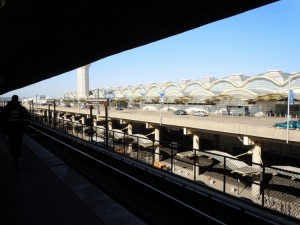
May 4, 5:00
Word of advice, when navigating a new city by bike, it’s a good idea to know where you are going and to avoid downtown at rush hour (at least until you are familiar with the streets). We left Tom’s place and tracked down a Capital Bike Share station to give it a try. The bike share program in DC is pretty sweet. They have over 1670 bikes and 175 stations throughout the city and it’s pretty cheap.
Once we found the summit, we met up with the rest of the Nebraska contingent and discussed the game plan for our Capital Hill meetings on Wednesday. I’m looking forward to meeting with Deb Fisher, Mike Johans, and Jeff Fortenberry’s people later this week.
After a pretty swanky dinner, we were treated to keynote speeches from League President Andy Clarke, and Transportation Secretary Ray LaHood followed by a discussion panel of NYC Transportation Commissioner Janette Sadik-Khan, President of Trek Bicycles John Burke, and VP of the Brookings Institute Bruce Katz. Below are a few points made by the speakers.
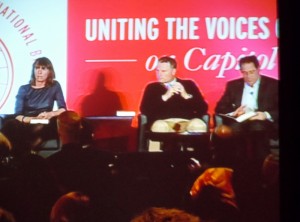
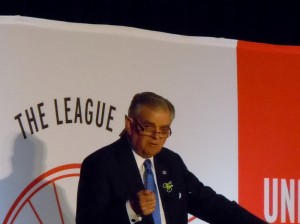
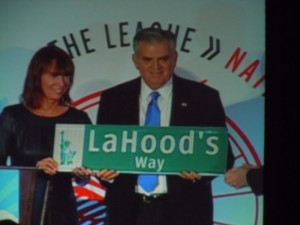
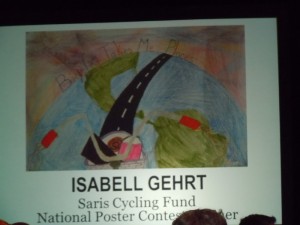
Andy Clarke:
-Goals for 2020 are 5% ride share and 50% decrease in injuries and fatalities.
-New league website to launch later this month.
Ray LaHood:
-Summit participation up from 120 to 750 over the last 25 years
-The Federal Government has spent $3.8 billion on bike and pedestrian infrastructure in the last 4.5 years.
-Transportation investment = Economic development.
-2011 bike deaths were up 9%. We need to do something about this.
-Two bicycle safety summits are planned for this spring.
Janette Sadik-Kahn:
-Presented Ray LaHood with a NYC street sign “LaHood’s Way”.
-Streets with bike lanes are 40% safer for all users.
-NYC sales tax reports show that along 8th and 9th street protected bike lanes, sales tax revenues are up 50% which are 16x higher than then borough wide numbers.
-Commercial vacancies along bike lanes in NYC are at zero.
-The 2007 PlanYC predicted that economic performance is tied to livability.
-NYC Bike lanes are polling better than Mayoral candidates.
-The Bike-lash (haters) doesn’t represent the population as a whole they just help to sell papers.
John Burke:
-The bike industry employs a lot of people (me included).
-Democracy is government of the people, for the people, and by the people…who show up (so get involved).
-The trick is to link love of cycling with safe places to ride.
-It is the responsibility of bike shops and avid cyclists to get people that want to ride involved politically.
Bruce Katz:
-In 1983 50% of young Americans had a drivers license. Now only 29% do.
-There is a trend of declining household size. 4.6 people per household in 1900, 3.38 in 1950 and 2.5 in 2010. Smaller households think differently about how and where they live.
-With density and proximity comes synergies for change and ideas
-Networks of open innovation and living close to work foster these synergies.
-We are at the beginning of a big trend.

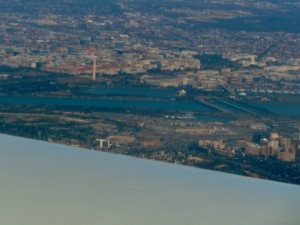
nice work Andy!